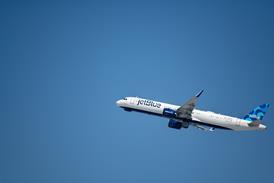GE Aviation has completed another key test examining one of the most critical technologies in development for the Passport engine selected to power the Bombardier Global 7000 and 8000 ultra-long-range business jets.
The Passport engine is designed with a 52in-diameter fan blisk. Rather than inserting blades into a fitting on a rotating disc, the Passport manufactures the blades and hub together.
That design results in a narrower hub which can improve the amount of airflow entering through the fan and make the aerodynamics of that airflow more efficient.
But it also introduces the risk that a single incident of bird strike or foreign object damage will require the aircraft owner to replace the entire 52in-diameter blisk instead of a single blade.
In fact, GE has reshaped the initial design of the hub to make it thicker, says Brad Mottier, GE Aviation vice-president and general manager of Business and General Aviation & Integrated Systems.
The heftier design ruggedizes the blisk to make it more resistant to damage, but also slightly reduces the efficiency of the airflow through the fan, Mottier says.
“But it’s still much more efficient than a bladed-engine of that diameter,” he says.
GE performed a water ingestion test late last week as part of a series of planned evaluations ahead of a scheduled certification of the Passport engine later this year.
Several more serious tests still await, including an engine blade-out test of the fan blisk.
Source: FlightGlobal.com























